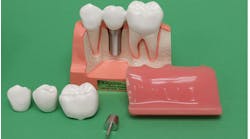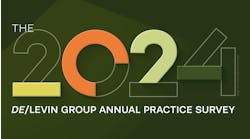Editor's note: Dr. Charles Blair was admired and known for his knowledge in dental coding, fee analysis, and strategic planning that helped thousands of dentists through the years. He founded Practice Booster in 2008, and he recently passed away after a long illness.
The primary focus of good clinical record-keeping is to establish patient care continuity. It’s equally important to create a legal record to protect patients’ interests, the doctor, and the dental team.¹ Some state laws require detailed descriptions, while other states have vague requirements.
While accurate records are a good goal, time and lack of strategic planning often hinder good recordkeeping. One way to be strategic about recordkeeping is to thoroughly understand the value of the CDT codes in creating clean and litigation-resistant records. CDT codes are not just for insurance billing. They’re crucial in developing a comprehensive dental record.
Here's a look at some of the oral evaluation codes used every day.
Documenting oral cancer screening
There is not a separate CDT code for an oral cancer screening, yet it’s included in the CDT descriptor for D0120 periodic oral evaluation, D0150 comprehensive oral evaluation, and D0180 comprehensive periodontal evaluation.
There are separate codes for taking tissue samples, assessments, and biopsies when a lesion is suspected. Because of the rise in cases of oral cancer,2 oral cancer screening is performed routinely, recorded, and explained to the patient during evaluation codes D0120, D0150, or D0180. The findings must be appropriately documented in the chart at the time of the evaluation. There is no assumption that the oral cancer screening was performed using the codes. If a patient has an cancerous oral lesion while in your care, it’s better to have evidence that you did the screening.
You might also be interested in
7 CDT codes you may be using incorrectly (or not using enough)
Adult fluoride billing and coding strategies
Documenting services without a fee
Some patient procedures are not routinely recorded in a patient’s chart because there’s no fee attached. There are codes for these procedures, and they should be used to document regardless of the fee. Using the appropriate nonclinical CDT codes to create legal dental records by establishing services with or without a charge or regardless of insurance is an efficient and legal way to make a dental history.
Let’s look at the following codes for demonstration.
Duplicating patient records
D9961: Let’s say a patient requests a record transfer to another dentist or a specialist. It is recorded in the patient's clinical notes but should also be recorded on the ledger where the business team can see it without entering the clinical chart. The code used is D9961 to duplicate/copy a patient record. It should be indicated on the posting that the procedure will not be billed to the insurance company. Some practices charge for copying documents. Either way, it must be recorded to prove where the records were sent. The practice may generally charge a reasonable fee for duplication of records. Duplication or copying refers to preparing the record for transfer electronically or manually. HIPAA indicates that a practice can only charge the actual cost of labor and materials for copying records. Some states may have a “no charge” requirement for the first copy of records. Contact your State Board of Dentistry to determine your state regulations.
Documenting missed appointments
D9986: This is the code for missed (broken) appointments. Indicate the amount of time of the appointment and any critical details in the notes. Repeated missed appointments will signal the need to converse with the patient regarding noncompliance. The record should also show how much you helped the patient keep their appointments, such as paying for a cab or ride share to get them to their appointments.
Patients who miss appointments, whether confirmed or not, should have the missed appointment recorded in their ledger and clinical notes, especially when they’re in active treatment. Missed appointments can seriously affect the success of the treatment.
Documenting canceled appointments
D9987: This code is for canceled appointments, which are often unrecorded if a patient gives 24-hour notice. All canceled appointments should be recorded because multiple canceled and rescheduled appointments indicate noncompliance and should be addressed to help the patient commit to the appointments.
Note: Payers typically do not reimburse for missed or canceled appointments. Private pay patients, with a prior written agreement, might be charged for a missed appointment or those canceled without sufficient notice. For patients of government programs, such as Medicaid or Medicare, the Centers for Medicare and Medicaid Services (CMS) state that no charge can be assessed to the patient for missed appointments.
Documenting compliance barriers
D9991: If you must assist a patient in maintaining scheduled appointments, this can be documented using CDT code D9991—dental case management, addressing appointment compliance barriers. Sometimes it's a matter of transportation, fluctuating work schedules, ot child care challenges that are out of the patient's control. Some dentists may schedule the patient on days the office is normally closed to accommodate their scheduling challenges.
In some litigation cases, the patient may insist that the staff never told them the importance of keeping their appointments or that postponing treatment would harm the outcome of their dental care. Documenting your practice efforts to assist patients in maintaining their scheduled treatment is evidence that the patient was informed of the importance.
While D9991 is not a “by report,” if this code is submitted, you must describe the administrative action and efforts made in association with the provision of this administrative service. A description of the individualized efforts should be noted.
Documenting patient care across multiple providers
D9992: This is for dental case management care coordination. Patients often need oral health care across multiple specialties and providers. Additional time to coordinate and facilitate a schedule for their treatment includes added time and resources. Missed or canceled appointments can affect the success of the treatment and relationships with the other providers. Careful documentation by the team of the steps to care and any roadblocks must be documented.
Documenting motivational interviewing for addressing patient literacy
D9993: This code reports using patient-centered, personalized counseling methods, such as motivational interviewing (MI), to identify and modify behaviors interfering with positive health outcomes. When reporting this service, the counseling method should conform to a recognized and professionally acceptable method intended to identify and modify behaviors interfering with positive oral health outcomes.
Note: Administrative codes such as D9991, D9992, D9993 should be used to track varying behaviors of patients and health-care providers; however, it is unlikely that these codes will be reimbursed. While they are not a “by report,” it is suggested that if the code is submitted, you must describe the administrative action and efforts made in association with the administrative service provision. A description of the efforts should be noted.
Other codes in the 2024 CDT Coding Resources such as Practice Booster’s Dental Coding with Confidence may help you document nonclinical patient care.3 If you have a situation that doesn't fit any code descriptor or nomenclature, use CDT code D9999.
D9999: This is used for a procedure not adequately described by an existing code. Describe the process in a narrative and include the report in the insurance billing.
Note: The above CDT codes may or may not be a covered benefit of the patient's plan. It depends on each policy provision. You should verify coverage and benefits before appointments to give patients a verified estimate. In today’s litigious society, there’s no excuse for not having accurate and well-documented dental records.
Editor's note: This article appeared in the January 2024 print edition of Dental Economics magazine. Dentists in North America are eligible for a complimentary print subscription. Sign up here.
James DiMarino, DMD, MSEd, CDC, researched and implemented advanced dental technologies as a Dentrix and Schick trainer. He is a patented inventor, educator, publisher, and lecturer. Dr. DiMarino worked for the insurance industry as a dental consultant, a state dental director, and a national dental insurance director. In 2018, he completed the certification requirements to become an AADC certified dental consultant. Contact him at [email protected].
References
- Berger R. The importance of written medical and dental records. Cooper Scully. December 8, 2021. https://www.cooperscully.com/news-and-resources/articles/the-importance-of-written-medical-and-dental-records
- Key statistics for oral cavity and pharyngeal cancers. American Cancer Society. Revised January 18, 2023. https://www.cancer.org/cancer/types/oral-cavity-and-oropharyngeal-cancer/about/key-statistics.html
- Blair C. Code Advisor. Practice Booster. https://www.practicebooster.com/search.asp






